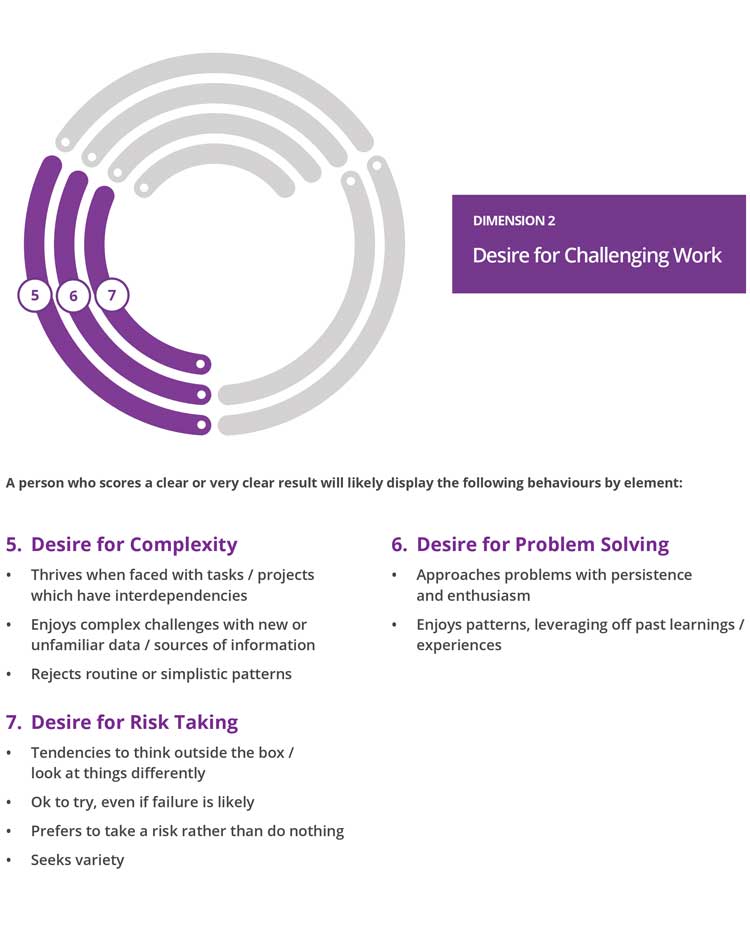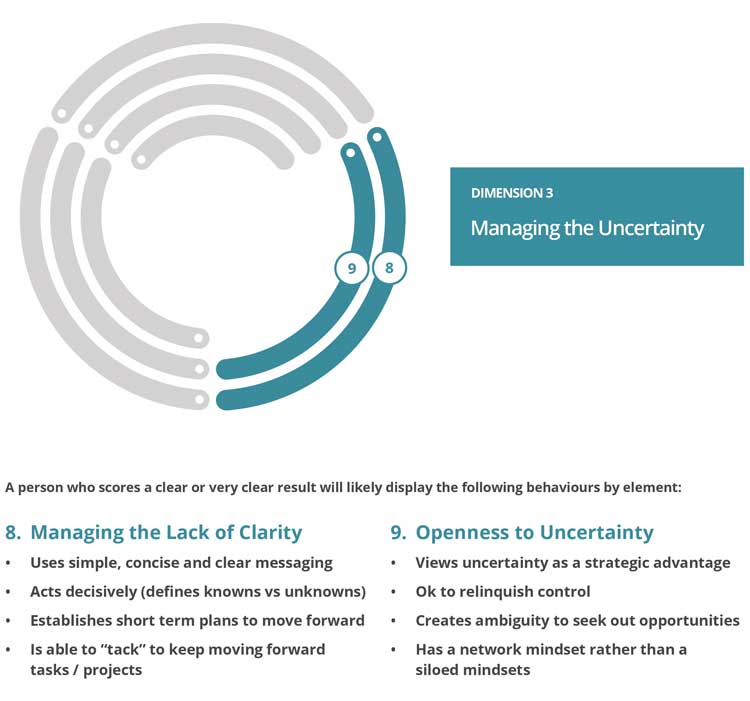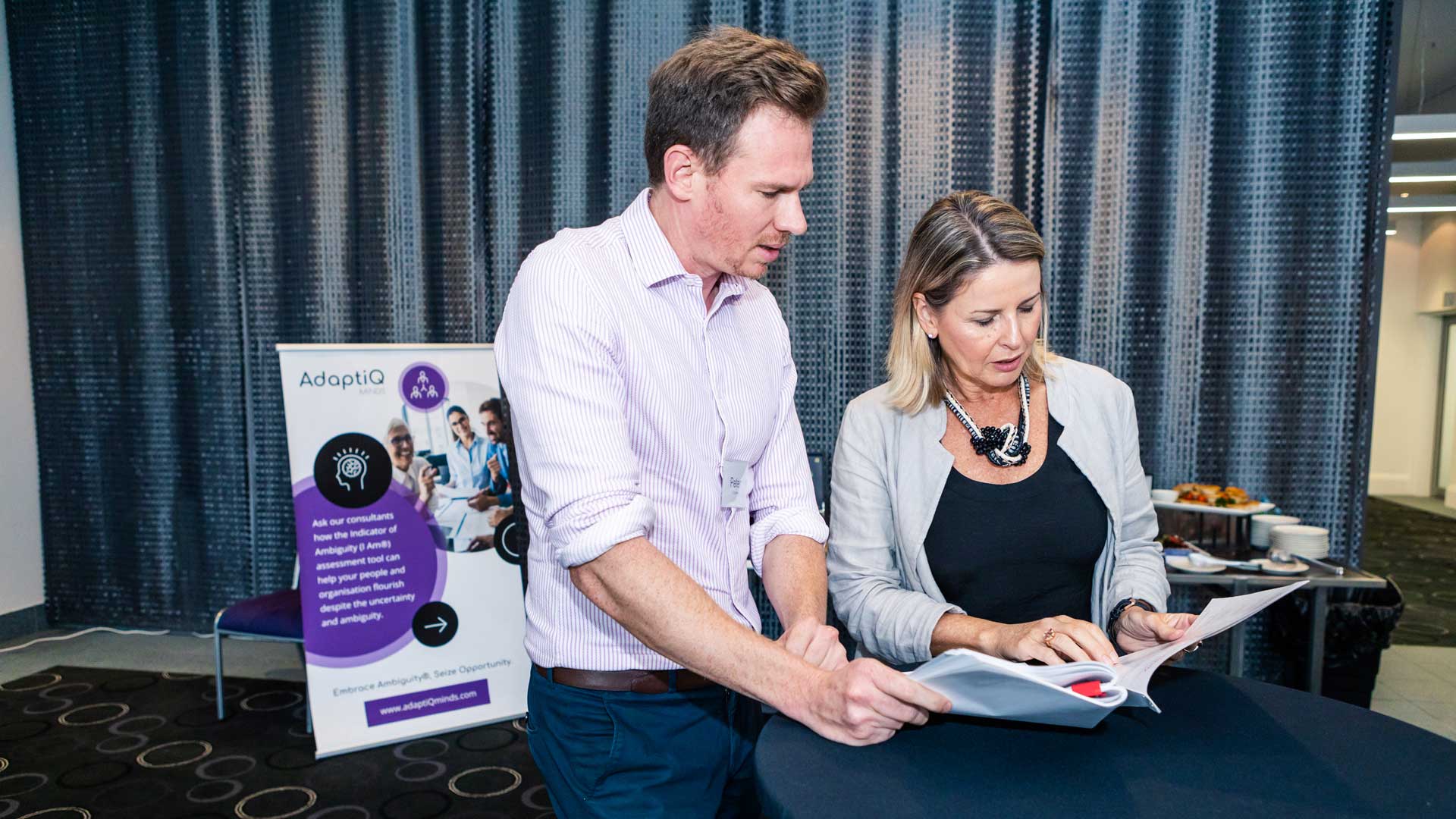Indicator of Ambiguity
(I Am)®
UNDERSTAND YOUR AMBIGUITY PROFILE

Why is Developing a Tolerance of Ambiguity Important?
Queensland University of Technology (QUT) research has shown that individuals with a higher tolerance of ambiguity are more productive and responsive in the disrupted, uncertain and complex world of work and benefit from increased job satisfaction and overall well-being.
A higher tolerance of ambiguity is positively related to improved
- Job performance
- Decision making
- Creativity
- Critical thinking
- Risk acceptance
- Job satisfaction
- Organisational commitment
- Health and wellbeing
- Emotional intelligence
- Teamwork
- Leadership
What is Tolerance of Ambiguity?
How comfortable are you with uncertainty, unpredictability, conflicting directions, and multiple demands?
The modern workplace is experiencing change at exponential rates. Never has the pace and complexity of change been so evident in our job roles, for example:
- Decisions must be made without the comfort of having all relevant data and information
- New and unfamiliar problems need to be resolved despite there being minimal or no experience in solving such problems in the past
- The volume of learning material is overwhelming, yet a commitment to continued learning is imperative for success
- Digital disruption, AI and Machine-Learning are impacting ‘how’ we do our work
Individuals have different levels of comfort with ambiguity and change. Your current level of comfort with ambiguity is your tolerance of ambiguity.

Understand Ambiguity
WHAT IS THE INDICATOR OF AMBIGUITY (I Am)®?
The Indicator of Ambiguity (I Am)® is a scientifically validated psychometric assessment.
The I Am® measures a person’s approach and response to uncertainty and ambiguity.
Results are plotted on a circular graph called the I Am® Compass that explores different dimensions of tolerance of ambiguity.
The I Am® assessment highlights strength areas and opportunities for development. It helps individuals identify and develop the core skills needed to increase ambiguity tolerance by linking development opportunities to research-based skills.
THE INDICATOR OF AMBIGUITY (I Am)® COMPASS
The I Am® Compass comprises three Dimensions, each with a number of Elements contributing to an individual’s tolerance of ambiguity.


Dimension 1
Comfort with Ambiguity
This dimension measures the ease you have with unclear, uncertain or confusing situations at work relating to relationships, unfamiliar situations, different ways of thinking or difficult problems.
Dimension 2
Desire for Challenging Work


Dimension 3
Managing the Uncertainty
Team Reports
The team report collates individual team members’ compass results. The individual results are rolled up to provide a ‘team ambiguity tolerance’ at a glance report.
The report’s richness sits with the weighting of preferences across the team. For example, if all team members have a clear comfort with ambiguity and all team members have a very mild tendency to manage the uncertainty, then it is likely that the team will be enjoying bouncing of ideas of each other and welcoming the disruption but not necessarily translating those ideas and disruptions into actions.
Wheel-spinning will likely occur, and stakeholders may be frustrated that the degree of uncertainty and ambiguity results in confusion, stress, and no reasonable plan to resolve it.
Understanding how the team weighting is orientated in relation to tolerance of uncertainty and ambiguity better equips the team to adapt their styles, approach and modes of engagement with others.
HOW WAS THE INDICATOR OF AMBIGUITY (I Am)® DEVELOPED?
The Indicator of Ambiguity (I Am)® assessment was devised from our research with Queensland University of Technology (QUT) and is designed to specifically identify how comfortable individuals are with ambiguity in the workplace.
Based on the Big 5 Personality Traits of extraversion, agreeableness, openness, conscientiousness, and neuroticism, the I Am® assessment tool is the first of its kind that specifically measures an individuals’ tolerance of ambiguity and their adaptability to change in the workplace.
The Indicator of Ambiguity (I Am)® tool has been used by thousands of adults ranging from Gen Y and Z’s to Baby Boomers and across a range of white and blue-collar industries.
It has been applied to employees across the spectrum of full time, part-time and casual employment in supervisory and non-supervisory roles.


Scientifically Validated
Through our research, the Indicator of Ambiguity (I Am)® assessment was scientifically validated as a psychometric scale with Chronbach’s alpha exceeding 0.6 (and many are higher) of each dimension and element, indicating good internal reliability.
The tool also has high face validity, content validity, concurrent validity, convergent and divergent validity and incremental validity. In other words, the measures are valid and predictive measures of work-related outcomes.
At Stanwell, we are committed to preparing our workforce for the future of work; the complexity and increasing pace of change and challenges and opportunities that uncertainties can provide. We included the Indicator of Ambiguity as a key assessment tool in our leadership development program to provide leaders with a view of personal and collective perceptions and responses to uncertainty. We explored the habits identified as key to building a tolerance of ambiguity and better understand how to modify or influence current behaviours, patterns and thoughts.
Brenda Carson
General Manager People & Culture – Stanwell

How to Build Your Tolerance of Ambiguity
Like learning to drive a car, you can think and respond differently to ambiguity with practice.
The I Am® Assessment is supported by a comprehensive, research-based development program that directly increases your tolerance of ambiguity by helping you make fundamental changes to the way you think about problems and situations and teaching you the tactics and strategies that people with a high tolerance of ambiguity use.
Our research has shown there are eight core skills that are mapped to our different dimensions of ambiguity. These skills can be developed to enhance your tolerance of ambiguity.
AMBIGUITY CORE SKILLS

Unlocking Inertia
There is a strong tendency to ‘get stuck’ when faced with significant complexity, new and unfamiliar environments or the risk of failure. Failure often impedes our concentration and consequently sabotages our performance.
When falling short of expectations, we have an instinctual reaction to fixate on it and internalise our failed efforts. This results in increased stress levels and reduces our self-confidence; the result being that our ability to control our emotions and problem-solve is impaired.
Instead of defaulting to dwelling on our mistakes, blaming others and spiralling into negative thoughts, we need to make a conscious effort to learn from failures and move forward. By creating a plan to ‘move forward’ despite the ambiguity, progress will result.

Assertion
When an individual exhibits assertion, they communicate directly and stand up for the rights and needs of not only themselves, but others as well.
Being assertive allows people to maintain a ‘strong’ personality, in that it enables people to act first when required, take on leadership roles and express their opinions without holding back. Assertive individuals also persist in obtaining what they desire and have the tendency to draw from their networks to assist with this.
Curiosity
Curiosity centres on a love of learning, a desire to understand new and unique concepts, listening to others and wanting to get to the ‘why’!
Curious people ask open questions and search for answers in their active minds. They are continually collecting data and ideas and are relentless in their quest to find a solution. They are focused on ‘what if’ possibilities and are not satisfied with the status quo or conventional behaviours and practices. They consider learning to be fun and are open to trying out new and unusual ideas or behaviours.
Each day presents an opportunity for a curious person as they seem to tirelessly ask questions, rarely get bored, and seek to collaborate for newness and innovation. They encourage participation from others, posing questions, creating strong professional relationships and networks for diversity of thought, sharing ideas and being open to connect the ideas of different people.

Flexible Thinking Patterns
Being flexible is the capability to be adaptable when change, uncertainty or ambiguity is present in the work environment. Such individuals are not rigid in thought but instead, consider aspects from others’ perspectives, take in data and information from varied and diverse sources, and have the ability to ‘stand back and see the bigger picture’ before ‘stepping forward towards the detail and solution’.
They synthesise data and information together with high but realistic expectations for success, not allowing perfectionistic traits impede progress. They do not get lost or bogged down in the details and rewire their mindset to accept that perfectionism is not obtainable nor (often) a worthy endeavour.
Cognitive bias is the way the brain filters and organises information. We receive far too much information for our brains to handle at once, so our brain simplifies information processing by creating connections based on existing knowledge and belief structures. Unfortunately, the brain isn’t always right and will often go for the fastest solution, the one that is easiest to understand and supports our own knowledge, beliefs or goals.
In order to think flexibly, we first need to be aware of and understand our cognitive biases. We can then learn to look past them or go around them.Given the unknowns of ambiguity, it is important to be flexible rather than fixed as past learnings and experiences may not assist to solve problems and make decisions.
Courageous Actions
The essence of courage is not acting in the absence of fear, but in spite of it. The challenge in acting courageously stems from an individual stepping out of their comfort zone; a place in which they feel safe. Ambiguity is a significant contributor to stress and anxiety in the workplace; when stress levels exceed our optimal performance-zone we lose effectiveness.
When faced with high stress our brain can feel hijacked by emotions and an inability to generate clear thoughts; this is known as the ‘amygdala hijack’. The amygdala is a structure within our brain that is responsible for our fight, flight or freeze response in the face of environmental threats; it is where our feeling of fear comes from. When we feel threatened or fearful, all our resources are dedicated to responding to the ‘threat’, leaving limited capacity for the logical brain to concentrate and activate problem-solving skills.
Acting Courageously requires active engagement of our ‘logical’ brain, de-escalation of our emotions, rejection of negative self-talk and stepping towards the unknowns and uncertainties.
Finding Focus
The pace and complexity of change means the workplace can feel chaotic and out of control; it is hard to know what to tackle first, how to identify the core issues and risks and how to achieve targets. While multi-tasking is an instinctive reaction, it is often the least productive; performance is significantly inhibited when juggling multiple tasks and competing deadlines.
Focused individuals get themselves organised and map out their day/week to be clear on tasks and deliverables. They seek to minimise distractions and identify and focus their attention on the key tasks at hand. They identify strategies to resolve critical issues, implement quick wins and set objectives to break down problems into more manageable pieces. They aim to eliminate unimportant or irrelevant details that can be overwhelming in an ambiguous situation.
The key is to focus on one task / initiative, eliminate the noise and competing agenda items or temptations to ‘just check email / voicemail’ – set parameters and focus your efforts where it will reduce the complexity and sense of confusion.
Creativity
Thinking differently is essentially thinking creatively. Creativity is essential for business success, growth and survival. Why? Because creativity is the driving force behind innovation. By looking at things from different perspectives and thinking differently, we can readily produce new and unique ideas. People who demonstrate diversity of thought are usually prolific questioners, use their imagination to think outside of the box, and often capably and constructively challenge the status quo.
Thinking in concepts rather than absolutes allows the ‘what if’ conversations to occur. When we open ourselves up to having ‘what if’ conversations, we also increase our chances of uncovering unique solutions to complex problems. We can promote creative thinking via continued learning, exploring new and unfamiliar topics, exposing ourselves to new environments and by providing challenging problems with constraints regarding how and when a solution is required (eg time, budget, resources, etc).
Creative thinking requires encouragement and a supportive, ‘fail fast’ culture whereby people have the time to experiment and embrace their mistakes as a part of their thinking and learning process.

Mindfulness
Mindfulness is the basic human ability to be fully present, aware of where we are and what we are doing, and not overly reactive or overwhelmed by what is going on around us. It is a curious and open mind which encourages letting go of past disappointments and future worries and focusing on the here-and-now in a non-judgmental manner.
Our world of plentiful distractions can absorb much of our mind impacting our capacity to be dedicated to the matter at hand; we struggle to be attentive.
By practising mindfulness, you become fully aware of your feelings, thoughts and behaviours and increase your ability to regulate emotions, manage stressful events by responding more rationally and objectively and be in the present moment. Mindfulness helps achieve a mental state of openness, awareness and focus.
Mastering Mindfulness will reduce anxiety, stress and the sense of feeling overwhelmed; it can provide clarity of thought, resulting in increased productivity and improved performance.
